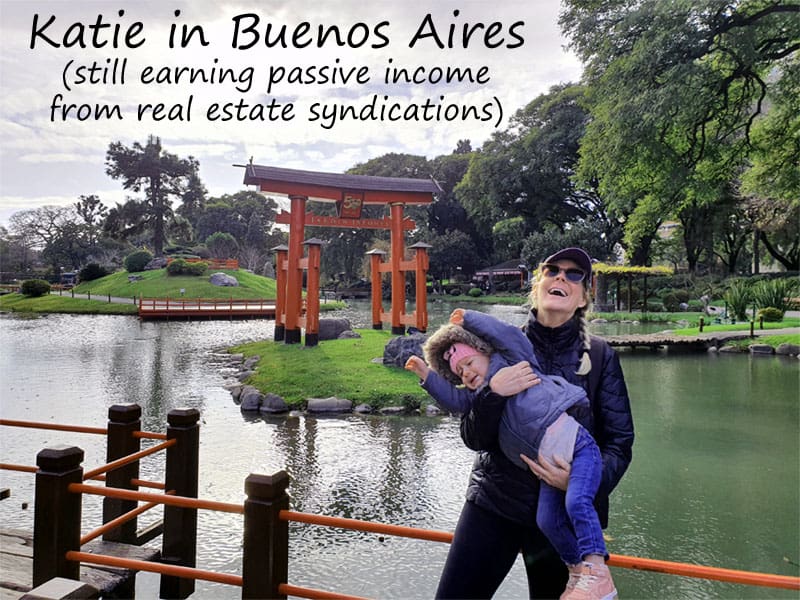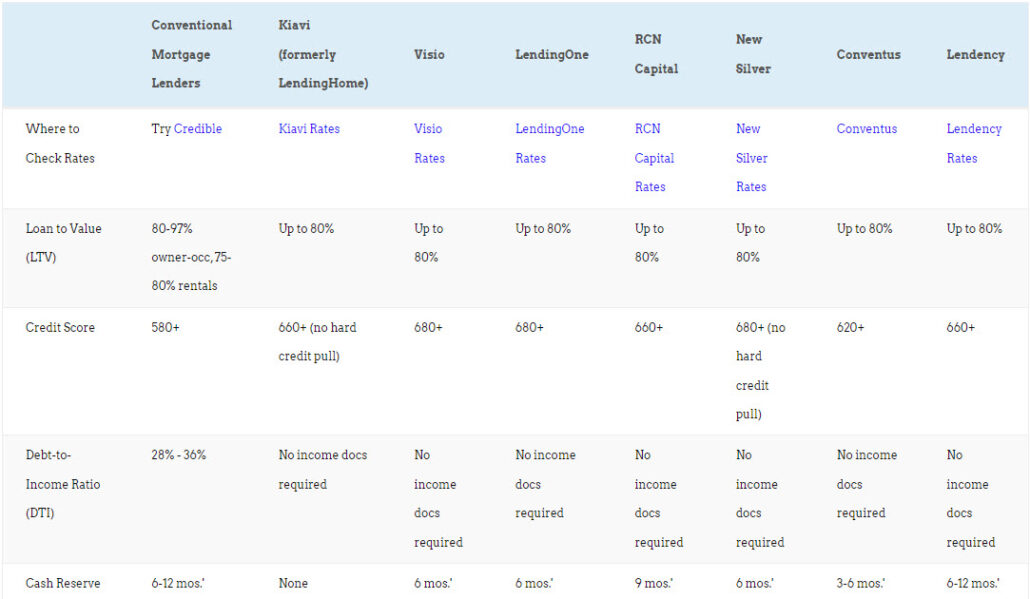
When people ask me about the return on investment (ROI) for real estate, they often balk when I respond that I aim for 15–30% returns. But I’m getting ahead of myself.
There are many ways to measure ROI on real estate investments. As an investor, you should understand all of them — or at least the ones relevant to your investment strategy.
You should also understand how different types of real estate investments have historically performed. What is a good ROI on a rental property? On a real estate syndication investment? What about returns on real estate crowdfunding investments?
Read on for the next five minutes, and you’ll have a far better grasp of real estate returns on investment.
Key Takeaways:
-
- Real estate returns come in two main forms: income yield and profits from appreciation.
- Alternatively, you can invest debt secured by real estate, which pays interest.
- Returns on real estate investments historically equal or surpass stock returns.
- A high return on investment doesn’t always come with high risk (although it can).
What Is ROI in Real Estate?
When you invest money, you expect to earn a return on your investment. In real estate, those returns come in several forms.
First and foremost, bear in mind that you can invest by owning real estate — an equity investment — or in debt secured by real estate.
Real estate debt investments include mortgage REITs (mREITs), debt crowdfunding investments, private notes, and secured debt funds. These typically pay returns as interest, although mREITs pay a portion of their profits.
Equity real estate investments include buying rental properties directly, or equity crowdfunding investments, or equity REITs, or most real estate syndication investments. These usually pay both ongoing income and profits upon sale.
Investors typically measure income yield by cash-on-cash return. This calculates the annual income you collect over the total cash you invested. For example, if you earn $800 this year on a $10,000 investment, you earned a cash-on-cash return of 8%. Simple enough, right?
Properties also appreciate over time. Even as you collect cash flow, the property also rises in value. That same property that paid 8% cash-on-cash return might have also risen in value by 4% that year, for a total annual return of 12%.
Annualized Returns
Real estate investors measure annualized returns in several ways.
Appreciation looks great on paper, but you don’t actually collect those profits until the property sells. So you might earn a 4–8% income yield for the first five years you own a property, then a 50% profit when it sells at the end of that time. How do you measure that as an annual return?
The easiest way to calculate it is with a simple average. If you earned a 60% total return (including both income and profits) on a property you owned for five years, that comes to a 12% average annual return (60% / 5 years = 12%).
But if you had actually collected the full 12% in returns each year, you would have been able to reinvest that money for compounding returns. So, investors take compounding into account by calculating an investment’s internal rate of return (IRR). It’s the annualized return, calculated as if you’d been able to reinvest each year’s returns along the way. The formula is complex and you can’t do that math on the back of a napkin, so use our free IRR calculator to run the numbers on any investment.
Lastly, you might see that some real estate syndications offer a “preferred return.” That protects you as a passive investor by giving your returns (up to that percentage) higher priority than the general partner or sponsor. When the property sells and profits get divvied up, you get paid out that return before the sponsor can take any returns for themselves.
For more information, read up on real estate investing terms here.
Infinite Returns
Deni and I love to talk about infinite returns on real estate investments — a confusing concept for many new investors.
In math, any return on a $0 investment represents an infinite return on investment. But, even though it’s possible to buy a rental property with no money down, you still have closing costs, right?
With rental properties, you can achieve infinite returns using the BRRRR method. It stands for buy, renovate, rent, refinance, repeat: you buy a fixer-upper, renovate it, and then instead of selling it as a flip you refinance it to keep as a rental property. When you refinance it, you can potentially pull your initial down payment and closing costs back out, assuming you created enough equity with your renovations. That leaves you with $0 of your own money invested, even as the property generates cash flow and appreciates for you over time. Those returns represent an infinite return on your $0 investment.
You can also achieve infinite returns on real estate syndications. It works the same way, simply on a larger scale: the sponsor renovates the property and refinances it, returning passive investors’ capital back to them. As passive investors, we get our money back but we keep our ownership interest in the property.
This model lets you keep reinvesting the same capital over and over again, letting it generate enormous returns over time.
Real Estate ROI Formulas
For cash-on-cash (CoC) returns, simply divide your annual income from an investment over the total amount you invested:
Cash-on-Cash Return = Annual Income / Total Cash Invested
Cash-on-cash returns are specific to you and your financing terms. If you want to calculate a property’s capitalization rate (cap rate), which ignores financing and just looks at the property’s cost, simply divide the annual net operating income (NOI) over the purchase price:
Cap Rate = Annual NOI / Purchase Price
Net operating income refers to the rental income minus any operating expenses such as property management fees, insurance premiums, property taxes, vacancy rate, and repairs or maintenance. It does not include debt service.
For average annual returns, you just take a mathematical average of the total returns (including both income and profits) divided by the number of years you held the property:
Average Annual Return = Total Returns / Years Owned
For example, say you invest in a passive real estate syndication with $10,000. It pays $400 in cash-on-cash returns over the first year, $500 in the second year, and $600 in the third year. At the end of three years, the sponsor sells the property and you get $13,000 back (your original $10,000 plus $3,000 in profits). You earned $4,500 in total returns over the course of three years, for an average annual return of 15%.
Historical Real Estate Return on Investment
The historical ROI on real estate depends on the type of investment and the location, of course.
One sweeping 145-year study of 16 industrialized countries found that rental properties paid a higher return (7.05%) than stocks (6.89%). But nowadays, most U.S. investors look for higher returns on both their real estate and stock investments.
Publicly-traded real estate investment trusts (REITs) offer great historical data as well. From 1972–2023, REITs have paid an average annual return of 11.1%. For the sake of comparison, the S&P 500 delivered an average return of 12.1% in that time period.
Real estate syndications pay even higher returns, although it’s harder to find historical data on these private equity real estate investments. Still, you can look at some larger syndicators and investment platforms for returns.
Syndication marketplace CrowdStreet has hosted 777 real estate syndication deals, and of those, 161 have gone full cycle and sold. On those, investors received an average annualized return (IRR) of 18.1%.
In our Co-Investing Club, here are the average annualized returns of several sponsors we’ve invested with:
-
- MAG Capital Partners: 19.8%
- Bronson Equity: 28.6%
- Wolfe Investments: 67.7%
- Rise48: 70.5%
Those average returns include hundreds of real estate syndication deals in total.
What Is a Good ROI on Real Estate?
Ask a dozen investors what’s a good ROI on real estate investments and you’ll get a dozen answers. But that won’t stop me from sharing my thoughts on the matter.
What Is a Good ROI on a Rental Property?
Annual property appreciation in the U.S. has averaged 4.7% since 2000, according to the Federal Housing Finance Agency.
As for rental cash flow, I personally like to see at least a 5–8% cash-on-cash return on rental properties. If you buy fractional ownership in real estate through platforms like Arrived or Ark7, you can typically expect yields in the 4–6% range.
Let’s call that a combined return in the 9–12% range.
I no longer invest in rental properties directly, because those returns don’t take into account your labor. Even if you hire a property manager, it still takes time and labor to find a good deal on a property, line up an investment property loan, oversee any needed repairs, and then manage the manager. Nowadays, I only pursue passive investment in real estate.
What Is a Good ROI on Real Estate Syndications?
In the Co-Investing Club, we look for group real estate investments that we can expect to earn 15–30% on.
Sound high? These investments come with some inconveniences compared to buying stocks or REITs, so I would argue that they have to pay higher returns to justify those inconveniences.
To begin with, real estate syndications aren’t liquid at all. Once you invest, you lock up your money for 2–7 years.
Many syndications only allow wealthy accredited investors to participate. If you’re a non-accredited investor, you have to go out of your way to find sponsors who allow you to invest. (Or you can invest as part of an investment club like ours, that does the networking for you.)
But the greatest challenge is the high minimum investment. Most real estate syndications require a minimum investment of $50–100K. You can invest through an investment club to pool smaller amounts to reach that minimum investment, however; in our Co-Investing Club, the minimum investment per person is $5K, and together we reach that $50–100K minimum.
What Is a Good ROI on Real Estate Crowdfunding?
I’ve invested in many different real estate crowdfunding platforms. I don’t expect the returns to be as high as real estate syndications, but I do expect more convenience.
I typically expect to earn around 10% returns on long-term real estate crowdfunding investments. Since 2017, Fundrise has averaged an 8.5% annual return after stumbling a bit in 2022 and 2023. I expect them to recover back to around 10% average returns, however.
On the debt side, Groundfloor loans have averaged 9.8% annual returns since its founding in 2013. With loan terms in the 6–18 month range, these also offer a rare short-term real estate investment. Groundfloor also offers short-term notes for periods as short as one month.
I also like Concreit as a place to hold money short-term. It pays a lower return of around 6–6.5% interest, but it comes with full liquidity: you can pull your money out at any time. That makes it a great place to hold funds while you’re waiting for longer-term real estate investment opportunities.
Do High Returns Mean High Risk?
Generally speaking, investments paying higher returns tend to come with higher risk. But it doesn’t always happen that way.
I don’t consider real estate syndications to have any higher risk than stock investments — yet they can pay several times the historical stock market returns. In fact, real estate syndications in many cases come with less risk. An apartment complex in Dallas might dip in value by 5–10% in a downturn, but it can’t disappear entirely. It’s a physical asset that generates predictable ongoing income. Stocks, on the other hand, can disappear overnight, going out of business and dropping 100% in value.
So how can real estate syndications pay higher returns, if they don’t come with higher risk?
To begin with, most people have never heard of them. Even those who have often don’t understand them, or can’t afford to invest in them. Remember, most require a minimum investment of $50–100K if you don’t invest through a club like ours. And that says nothing about the lack of liquidity, which makes some investors nervous.
As for rental properties, the risk depends on your skill level. Experienced investors can reliably earn 8–15% returns on rental properties. They can accurately calculate rental cash flow before buying a property.
Inexperienced investors can lose their shirt, however. It’s one reason why we recommend that investors make a choice: stick with passive real estate investing or commit to learning active real estate investing as if it were a side hustle. If you only want to diversify your portfolio and don’t want a side business, stick with passive investing.
Where Real Estate Fits in Your Portfolio
Real estate and stocks complement each other in many ways.
Stocks provide liquidity, strong growth potential, and easy ways to invest through tax-sheltered accounts like 401(k)s and IRAs. It’s also easy to diversify your stock portfolio by buying index funds and other broad exchange-traded funds (ETFs), giving you instant access to thousands of stocks across the globe. Downsides include volatility and relatively low income yields.
Real estate provides reliable passive streams of income, outstanding tax benefits, a hedge against inflation, and a low correlation to the stock market. The stock market might crash, but that doesn’t mean your real estate investments will. Downsides include lack of liquidity, high minimum investments, and higher skill required than just investing in an index fund.
Personally, I invest in real estate as an alternative to bonds. It serves all the same purposes of bonds in my portfolio, from reliable income to diversification from stocks.
“But what about risk? Isn’t real estate riskier than bonds?”
Sure, government bonds have a low risk of defaults. But that’s not the only kind of risk affecting bonds. Bonds also come with interest rate risk: if interest rates go up, the value of older bonds drops. Further, bonds come with inflation risk: inflation takes a bite out of your real returns. If you bought a Treasury bond paying 2% and inflation runs at 3%, you’ve effectively lost 1% on your investment.
Real estate tends to rise proportionately with inflation. In fact, rents are a leading driver of inflation. People pay the going rate for properties, whatever the value of the currency.
Final Thoughts on Real Estate Returns
Real estate comes with high potential returns from both annual cash flow and appreciation. In my own investments, I aim for 15–30% as a real estate return on investment.
Like all investments, real estate comes with risks and downsides as well. The high initial investment cost for rental properties and real estate syndications puts off many would-be investors. It also takes skill to invest in rental properties, such as learning accurate ROI calculations and understanding expenses like vacancy rates and maintenance costs. Monthly cash flow is not the monthly rent minus the mortgage payment!
If you’re new to real estate investing, start with real estate crowdfunding and real estate syndications. Check out real estate investment clubs like our Co-Investing Club to invest as a group and reduce your initial cost of investment. You can spread your money among many real estate markets and property types. For example, we’ve invested in not just multifamily apartment buildings but also mobile home parks, industrial real estate, retail properties, and self-storage facilities.
If you want to invest directly, commit to learning rental property investment as a business venture. Learn how to forecast repair costs and other annual operating costs. Learn how to analyze current market conditions, how to vet property management companies, how to manage contractors. While it can be rewarding to invest in residential properties, it requires plenty of labor and skill on your part.
Most of all, don’t settle for mediocre returns. If you don’t expect to earn at least 8% in average annual investment gains, you might as well just invest in the stock market and save yourself the upfront costs and headaches.♦
What kind of real estate returns do you look for when you invest? Do you invest for strong passive income or aim for higher capital gains? How do you mange risk versus returns on real estate investments?
More Real Estate Investing Reads:
About the Author

G. Brian Davis is a real estate investor and cofounder of SparkRental who spends 10 months of the year in South America. His mission: to help 5,000 people reach financial independence with passive income from real estate. If you want to be one of them, join Brian and Deni for a free class on How to Earn 15-30% on Fractional Real Estate Investments.



























What strategies do you think work best for maximizing ROI in today’s market fluctuations?
I practice dollar cost averaging, rather than trying to time the market. I invest $5K in a new real estate syndication deal each month through our Co-Investing Club, aiming for as much diversification as I can. A few will underperform, a few will overperform, and most will fall in the middle of the bell curve.
I’m just starting out in real estate investing. What’s the minimum cash-on-cash return you’d accept, when considering buying a rental property?
For a rental property, the least I’d accept is around 8%. For a passive real estate investment such as a syndication, some investments don’t start paying distributions for a year or two, or they may pay at just 4% for a few years before they sell the property and pay out all the investors. Because those investments are completely passive and don’t require any work on my part, and because the bulk of the returns often come from profits on sale, I accept a much lower cash-on-cash return on real estate syndications.
I’d always been a little fuzzy on cash-on-cash return vs preferred return. Thanks for the breakdown!
Glad to hear it was helpful!
How does location impact ROI, and are there emerging markets that offer exceptional potential for real estate investors?
Historically, slower-growth and secondary markets have offered better cash flow and cap rates, but less appreciation. That may not be the case at this exact moment, as some of the hottest housing markets from the pandemic era experienced a correction. As for emerging markets, do some research on Argentina, where you can score a bargain right now because of their currency crisis.
What steps can I take to successfully implement the BRRRR method in my real estate investment strategy, ensuring I achieve infinite returns while effectively managing the renovation and refinancing processes?
Hi Angus, it sounds like you understand the premise, so the rest is execution. A few quick tips:
1. Heavily screen contractors, and stay on top of them every single day during the renovation. Visit the job site every day if you can, and point out quality issues before they get too far.
2. Establish relationships with lenders before you need them.
3. Most important of all, run your numbers through a cash flow calculator, and be extremely conservative with your estimates for costs like ongoing maintenance, repairs, vacancy rate, etc.
Best of luck!
You always want to keep an eye on the risk-return balance in real estate investments. Thanks for the thoughtful overview.
Glad it was helpful Damian!